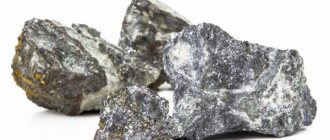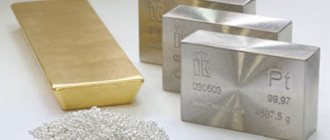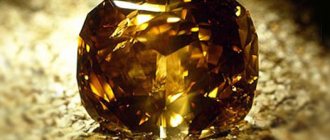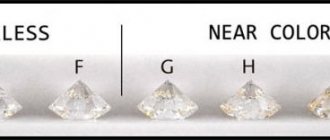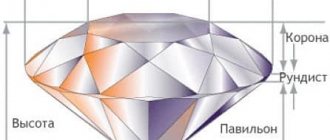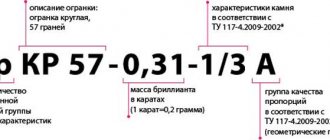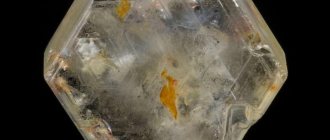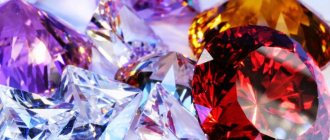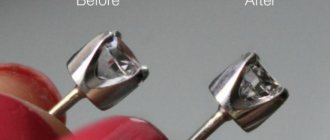Culture
Diamond, whose name from Greek means “indestructible”
, is formed at a depth of about 200 km underground under enormous pressure and heat.
They come to the surface during volcanic eruptions, or are mined in old volcanic zones. The diamond is between 990 million and 4.2 billion years old
.
A diamond is a diamond that has been cut in such a way as to highlight the natural brilliance of the stone.
To find out how perfect a diamond is, it is assessed according to the 4 characteristics of the “4Cs”
: carat, color, cut and clarity.
A carat is used as a unit of measurement for the weight of a gemstone and is equivalent to 1/5 of a gram. The higher the carat of a diamond, the higher its price.
Several outstanding diamonds have gained worldwide fame due to their history.
The biggest diamonds
Diamond "Great Mogul"
"Great Mughal" was named after Shah Jahan, the ruler of the Mughal Empire who built the Taj Mahal. The diamond was discovered in the Golconda diamond mines in the 1650s, and its weight of 787 carats made it the largest diamond in India.
.
The diamond was cut into a rose-shaped diamond with a bluish hue. However, the stone was lost first during the war with Persia, and then after the assassination of Nadir Shah, who acquired it in 1739.
After 1747 the "Great Mogul" disappeared
, and was never seen again, at least not in his original form.
There are many versions regarding the fate of this diamond. It is believed that the famous Orlov diamond was subsequently made from it, but the secret has not yet been revealed.
Diamond Cullinan
The Cullinan I was the largest diamond in the world until the Golden Jubilee was discovered.
It was made from a fragment of the largest diamond in history - the Cullinan diamond weighing 3106 carats.
. The diamond, also called the “Great Star of Africa,” was found on January 26, 1905 in South Africa. It was named after the mine owner, Thomas Cullinan.
The Cullinan was given to King Edward VII on his birthday. The cutting of the largest diamond was entrusted to the famous cutters, the Assker brothers from Amsterdam. Since the diamond had cracks, it could not be made into one large diamond
.
Cutting maker Josef Asker spent several months preparing to make one single sure blow on the stone, which would split it along natural cracks. The excitement was so strong that after the ceremonial blow, Asker lost consciousness, but the diamond split into two halves.
The largest of the nine fragments received,
the Cullinan I diamond, adorns the scepter of the British Queen
, and can be seen in the Tower of London with the rest of the British crown jewels.
Diamond "Golden Jubilee"
The Golden Jubilee is the largest cut diamond in the world
. The golden-brown diamond supplanted the Great Star of Africa and was discovered in 1980 at the Premier mine. For a long time it remained unnoticed, and it was given to the famous cutter Gabriel Tolkowsky to test new cutting tools.
Much to the surprise of many, the Golden Jubilee turned out to be a real treasure weighing 545.6 carats.
(up to cut 755.5 carats).
The resulting diamond was blessed by Pope John Paul II, the Supreme Buddhist Patriarch and Grand Imam of Thailand. It was presented to the richest king in the world - the King of Thailand
while celebrating his anniversary.
Diamond "Orlov"
"Orlov" is considered the largest diamond of the Diamond Fund
Moscow Kremlin. The origin of the stone, which has the shape and proportions of half a hen's egg, dates back to the 18th century in southern India. Although part of the Orlov's history has been lost, it is believed that it once served as the eye of a statue in an Indian temple.
The stone was stolen by a Frenchman who converted to Hinduism and even became a novice in the temple to carry out his plan.
As a result, the diamond was sold to Count Orlov, who presented it to Catherine II
.
The Orlov is a pure white diamond with a bluish-green tint and is very rare as it has retained its original Indian rose cut.
The majestic "Cullinan" and the mysterious "Great Mogul"
All of the world's most famous diamonds are made from the largest diamonds, each with its own history and name.
The real giant was the Cullinan, found in 1905 in South Africa. Its original weight was 3106.75 carats. As a result of its cutting, it was possible to obtain 105 precious stones of various sizes, and the “Big Star of Africa” (530.2 carats) was for a long time the largest diamond in the world.
The names of diamonds obtained from the Cullinan cut have serial numbers as their weight decreases.
Read more about this legendary stone in the article “The Fascinating History of the Cullinan Diamond.”
In the Middle Ages, the rulers of all countries of the world dreamed of getting the Great Mogul diamond weighing 747 carats and a large diamond made from it weighing 279 carats. As a result of a series of conspiracies, in 1747 its last owner, Nadir Shah, was killed and the stone disappeared without a trace. Scientists and researchers are still trying to discover his whereabouts, coming up with various legends and versions about his future fate.
The most expensive diamonds and diamonds
Diamond "Sancy"
The most famous owner of the Sancy diamond is King Henry III
, who purchased the stone from his attorney Nicolas de Sancy. The stone served as a beret decoration to cover the king's premature baldness.
According to legend, the messenger who was supposed to deliver the stone was killed. However, the faithful servant kept the stone, which, after opening, was found in his stomach.
The diamond was sold to King James I of England and then to Cardinal Mazarin, who left it to King Louis XIV. During the French Revolution, it disappeared along with the Regent Diamond and the Hope Diamond.
As a result, Sancy was sold to the Louvre for a million francs
, and is still stored there. Its price has not been established, but it is considered priceless.
Diamond "Kohinoor"
The Kohinoor Diamond or the Mountain of Light has a long history.
. The first mention of it appeared in 1304, when King Babur discovered a diamond, and since then it passed to all the rulers of the Mughal Empire - a state in the modern territory of India and Pakistan.
Hindus, Mughals, Persians, Afghans, Sikhs and the British fought desperately for the right to possess it throughout history. Almost all Kohinoor owners suffered an evil fate: death, poisoning, betrayal
. From the once huge stone of 793 carats, 105 carats (21.6 grams) remain.
In 1850, the diamond was given to Britain's Queen Victoria, who wore it as a brooch for a long time. The famous Kohinoor was worn by Queen Alexandra, Queen Mary and is now in Queen Elizabeth's crown.
at the Tower of London. Its price has not been established, but it is considered priceless.
Diamond "Hope"
Perhaps the most famous diamond in the world is the Hope Diamond. No one knows how large the stone was before it was cut, where it was found, or who gave it its original shape. It was first mentioned by the French merchant Jean-Baptiste and sold to King Louis XIV.
Some experts believe that it was stolen from a statue of the ancient Indian goddess Sita
. It passed to King Louis XVI and Marie Antoinette, then was stolen and reappeared in 1829. Banker Henry Hope purchased the diamond and the stone is named after him.
The subsequent numerous owners of "Hope" suffered an unfortunate fate
: violent death, illness, loss of a child and accidents. The Doomstone gained the reputation of being cursed, and it was believed that everyone who touched it would die a terrible death.
Since 1958, the diamond has been in the Smithsonian Institution
in USA. Its price is $350 million.
Kohinoor and its tragic story
In 1304, the conqueror of India, King Babur, first saw a diamond, which his soldiers took from the eye of one of the statues of a local temple. Due to the extremely bright light emanating from this stone, Babur named it “Kohinoor” or “Mountain of Light”. That is what it is called to this day.
At the dawn of its history, the diamond brought only good luck to its owners, but after it was once stolen from a Hindu temple, it became a symbol of discord and strife.
Ultimately, the gem was presented to the Queen of Great Britain, who demanded that it be recut, which was successfully carried out in 1852.
As a result of recutting, a diamond with a natural weight of 793 carats was left with a fragment of 105 carats, which does not convey the natural brilliance of the jewel.
Currently, the Kohinoor crowns the Great Royal Crown of Great Britain and is kept in the Tower of London.
Regent's Diamond
The Regent Diamond, also known as the Queen of Hearts, was found in 1698 by a slave in a mine who eventually paid for it with his life. The captain who found a hidden diamond killed a slave, sold the stone weighing 410 carats
to an Indian trader and then to a British businessman, Thomas Peet, in 1701. It was reduced to 141 carats.
The Regent Diamond is considered one of the most beautiful in the world. It is white, but with a subtle bluish tint that not everyone sees. The diamond became the adornment of Marie Antoinette, Napoleon, King Louis XVIII, Charles X and Napoleon III
. Now it is in the famous Louvre Museum.
Diamond "Millennium Star"
The Millennium Star is the 10th largest and 2nd largest D color diamond.
. Before cutting it weighed 777 carats, and after it weighed 203 carats. A majestic diamond without external or internal flaws was of exceptional purity.
The stone was purchased. It took more than 3 years to give the diamond its classic pear-shaped shape using lasers. "Millennium Star" with 11 blue diamonds
was mined from the Premier mine in South Africa. In 2000, these amazing diamonds from the Millennium collection were presented at an exhibition in London.
Diamond Taylor-Barton
The 241-carat diamond, from which the famous diamond was later made, was found in the Premier mine in South Africa. The famous jeweler Harry Winston cut the stone, which became pear-shaped and weighed 69.42 carats. A stone of amazing transparency and beauty became the first diamond sold at auction for more than a million dollars.
.
Its buyer was Richard Burton, who bought it for his wife, the famous actress Elizabeth Taylor. Elizabeth could wear such a treasure only a few times a year under the protection of guards, and the first time she appeared with it was at the celebration of Princess Grace's birthday in Monaco.
When the actress divorced Barton, she sold the diamond for $5 million and used the proceeds to build a hospital in Botswana. It is believed that this is the first time that a diamond brought anything other than misfortune.
.
Blessed by the Pope "Golden Jubilee"
The record holder among precious stones is the “Golden Jubilee” diamond (545.67 carats), presented in 1995 by subjects to the King of Thailand on his 50th anniversary.
The diamond itself, weighing 755.5 carats, turned out to be of excellent quality and had virtually no serious defects. That is why it lost so little (about 30%) of its own weight during processing, and the gem received an unusually beautiful cut.
The largest diamond in the world has a golden brown color and large facets that disperse light evenly. For its beautiful appearance and the presence of pure light, the Golden Jubilee was blessed by Pope John Paul II, the Supreme Imam and the Supreme Buddhist Patriarch of Thailand.
Sapphire blue "Hope"
The Hope Diamond, which has an amazing sapphire-blue glow, has dozens of names given to it by its new owners. It is believed that this stone is the most unlucky in the world and brings only bad luck and death to its owners.
It weighs 45.52 carats and is believed to have been stolen from a statue of the ancient Indian goddess Sita in the Middle Ages.
The stone has been the cause of thefts and murders dozens of times, and many of its owners have died in the most mysterious ways.
The creators of the film “Titanic” decided to play on this story, making “Hope” the prototype of the “Heart of the Ocean” diamond and adding additional tragedy to the fate of this precious stone.
Since 1958, “Hope” has been kept in the collection of the Smithsonian Institution (USA), where it was donated free of charge by its last owner, Harry Winston. Its insured value is $350 million.
Read more about the history of this amazing stone in the article “The Hope Diamond: the prototype of the Heart of the Ocean diamond from the Titanic.”
The most famous diamonds
Although life goes by quickly, art never dies. This also applies to jewelry. States arise and fall apart, the people who created them leave. Diamonds do not disappear, they simply change their owners, traveling around the world.
This article will talk about the most famous diamonds in the world. Some of them may have been lost, but the rest are displayed in the windows of fashion stores or hidden from public view in private collections.
However, the whole world still knows about the existence of each of these diamonds, because it is not so easy to hide the existence of such majestic jewelry. Our list is not just a list of diamonds according to their size, but also a ranking based on color, shape and, of course, their own unique history.
The Golden Jubilee. This creation of nature is currently the world's largest polished diamond, weighing 545.67 carats. The stone was found in South Africa, and the stone was cut by the well-known Gabi Tolkowski. This diamond is yellow-brown in color and has long been called the “Unnamed Brown.” However, in 1997, the stone was purchased as a gift for the Thai King Bhumibol Adulyadej on his “golden” 50th anniversary of his reign. It was then that the priceless diamond received its current name, but its price remained a secret.
Cullinan. The second place in the ranking goes to the Cullinan diamond. The original weight of the stone was a record 3106 carats and it was found on January 27, 1905 in South Africa. The diamond was named in honor of Sir Thomas Cullinan, who founded the Premier mine, owned by DeBeers, where the discovery was made. The gem was bought for a million dollars by the government of the local republic of Transvaal and then presented to the English king Edward VII. This was done as a thank you for granting the former colony self-government rights at the end of the Boer War. In 1908, the stone was split into several pieces by Dutch jewelers. The largest piece was “Cullinan” at 530.2 carats, also called the “Big Star of Africa”. Today, the diamond adorns the scepter of Edward VII, which is kept in the Tower of London and is part of the royal treasures of England. Jewelers can only approximate the stone; it costs about $400 million, but, naturally, is not for sale.
Incomparable Diamond. A diamond with the name “Incomparable” was found in the early 80s of the 20th century in the town of Mbuji Maiv, in the Congo. The weight of the find was 890 carats. The stone was cut by a team of jewelers led by Marvin Samuels. As a result, the weight of the largest diamond was 407.48 carats. It was this piece that was called such a big name. The owners tried to sell the diamond several times, first at Christie's auction, and then on Ebay. However, for some reason there were no buyers for the unique stone priced at $15 million.
The Centenary. On July 17, 1986, a diamond called the Centenary Diamond was found in the South African Premier mine. The rough stone weighed 599.1 carats. The discovery was timed to celebrate the centenary of DeBeers, the world's largest diamond miner. The diamond was cut by jeweler Gabi Tolkowski for almost three years. And the result turned out to be appropriate - the “Centenary” diamond has impeccable polishing and perfect clarity. Now it weighs 273.85 carats. The jewel was insured in May 1991 for more than $100 million. Today the diamond is part of the British Crown Jewels and is located in the Tower of London.
Jubilee. In 1895, a unique diamond of 650.8 carats was found at the Jagersfontein mine in South Africa. The find quickly became the property of an association of London gem dealers, which included companies such as Wernher, Beit & Co, Barnato Bros. and Mosenthal Sons & Co. The result was the Jubilee Diamond, also known as the Reitz Diamond, weighing 245.35 carats. The stone received this name in honor of President Francis William Reitz, in whose possession the discovery was made. However, the diamond was renamed in honor of the 60th anniversary of the coronation of Queen Victoria of England. Now the jewel is in the collection of Robert Mouad, being a real diamond of the entire collection.
The De Beers. In 1888, the De Beers company was just preparing to be born, and a rare diamond had already been found in the mines. The light yellow gemstone weighed 428.5 carats. After polishing, it was reduced by almost half and weighed 234.65 carats. The De Beers diamond is one of the ten largest in the world. In 1889, the stone caused a sensation at the World Exhibition in Paris and was purchased by Maharaja Rajendra Singh. For a long time, the stone was not set into a frame at all; perhaps the ruler wore it in a turban. In 1925, the Maharaja appeared in Paris with a bunch of precious stones, wanting to create a unique necklace, which was to be decorated with this giant diamond. For 3 years, Cartier craftsmen worked on an unusual piece of jewelry called the Patiala Necklace. However, in the 50s, England denied tax benefits to the princes and they began to sell off their jewelry. Among the jewelry sold was a necklace, along with a diamond. Although the necklace itself was discovered by chance in London in 1998, the De Beers diamond turned out to be lost. Most likely, it adorns someone's private collection.
The Millennium Star. If you can only imagine the most ideal diamond, extremely clear, then this will be the “Millennium Star”. The stone was found in the Congo in the 80s of the 20th century. During the turbulent times of the civil war, the De Beers company came to the rescue and acquired the jewel. Jewelers processed the stone for three whole years using a laser. The result was a pear-shaped diamond weighing 203 carats, unveiled in London on the eve of 2000. One of the experts in the world of gemstones, Harry Oppenhaer, bluntly stated that the De Beers Millennium Star is the most beautiful diamond ever seen by people. It was the “Millennium Star” that was the main example of the De Beers Millennium Diamond Collection exhibition. The original diamond weighed 777 carats and was cut into three parts, the largest of which became the “Star”. For diamond cutting, a special operating room was even built, which in terms of equipment and cleanliness resembled a medical one.
The Orlov. There are quite a few myths and legends about the origin of the Orlov diamond. According to one of them, the stone was once the eye of Vishnu, the Indian god. However, a certain British deserter was able to steal this stone from the temple in the early 18th century. The diamond then went through a series of adventures, changing through a series of owners. But then it fell into the hands of Grigory Orlov, who decided to purchase the stone as soon as he learned of its existence. The jewel was purchased by the Count in Amsterdam in 1773, but not for himself, but for his beloved, Empress Catherine II. Then the Indian stone cost 90 thousand rubles, and the name of the new owner was passed on to him. However, the stone did not bring Orlov happiness - the empress never fell in love with him, but she still kept the diamond for herself. He was able to decorate Catherine's scepter. However, historians claim that the count did not buy the diamond; the transaction was completed by the empress herself for public money, who came up with the story in order to clear herself of accusations of extravagance. The Orlov diamond is very rare, because it has retained its original shape, and its color is very beautiful - transparent, but with a slight green-blue tint. Today the stone is located in the Diamond Fund, its weight is 189.62 carats, and originally it weighed about 400 carats and could be part of the famous “Great Mogul” diamond.
The Regent. According to legend, in 1698, an Indian slave found a large, 410-carat diamond in the Golcondi mine. To hide the find, the slave had to cut his thigh and hide it under a bandage. The slave decided to buy his freedom at the price of the jewel. However, an English sailor took possession of the stone and killed the previous owner. The diamond was then sold for £1,000 to the governor of Fort St. George. In 1717, Philip II of Orleans became the owner of the diamond, who bought it for King Louis XV. Since then, the stone began to be called “Regent”. He becomes a companion to the French kings, decorating the crowns of Louis XV, XVI and Marie Antoinette. During the French Revolution of 1792, the treasures were looted, but the diamond was soon found. The country's Republican government soon pawned the "Regent" to the wealthy Moscow merchant Treskov, but the stone was bought back by Napoleon, who ordered it to be set into the hilt of his sword. In 1886, the diamond was finally bought for 6 million francs for the Louvre - there was a sale of treasures of the French crown.
The Premier Rose. The famous South African Premier mine produced another amazing find - a diamond weighing 353.9 carats was found in 1978. Two companies became co-owners of the precious stone: Mouw Diamond Cutting (Johannesburg) and William Goldberg (New York). His name itself consists of two parts. The first is exactly the same mine in which the discovery was made. The second, “Rose,” is the name of the wife of the South African co-owner of the stone. And in this case, the stone was polished by a whole team of jewelers. The result was a peach-shaped diamond weighing 137.02 carats. In 1979, it was put up for sale and the jewel was purchased for $10 million by a person who wished to remain anonymous. However, the diamond recently surfaced in the collection of famous collector Robert Mowad.
The Tiffany Yellow Diamond. This diamond is one of the yellow ones, being one of its largest representatives. The diamond was discovered in 1878 at the Kimberley mine in South Africa. It was polished in a standard round shape, and the Tiffany weight was 128.5 carats. The diamond was only worn twice. The first time this happened was during the Tiffany's Ball in Newport. It was then worn by prom queen Sheldon Whitehouse. Another woman to wear a diamond was Audrey Hepburn. Currently, the jewelry belongs to Tiffany & Co, which bought it immediately after its discovery for 18 thousand dollars. The diamond was put on public display in the window of a company store in New York.
Koh-i-noor. Many people associate the word “kohinoor” or “kohinoor” with a brand of pencils, but this is one of the most famous diamonds. Its history can be traced back to 1304, but legends claim that the stone was found much, much earlier. “Kohinoor” is said to have been found in the 3rd millennium BC. in South India in the famous Golcondi mines. Among its first owners, we can note the Indian legendary hero Karna, whose exploits are described in the Mahabharata. For a long time, the diamond adorned the turban of the rulers of the ancient state of Malve. There was a legend according to which, if a stone fell from the raja's turban, the entire people would turn into slaves. Actually, this is what happened in 1304, when Malva was conquered by Sultan Ala ad-Din. Among other trophies, he received “Kohinoor”. Until the 19th century, the stone was captured by one ruler or another, but now it ended up in England. Then the powerful East India Company became its owner. Soon, entrepreneurs presented Kohinoor as a gift to Queen Victoria, and since 1851 it has been in London. Until then, the stone still retained its ancient Indian cut; Victoria wore it as a brooch. However, after the death of the queen, the diamond ended up in the treasury of the British court and was soldered into the king's crown. In 1862, it was recut, led by the royal mineralogist John Pennant. He gave the diamond a flat shape. Processing of the stone reduced its weight from 191 to 108.9 carats. Many criticized this step, their doubts are understandable - after all, the diamond has lost part of its historical value.
Taylor-Burton. The diamond became famous throughout the world thanks to its star owners. In 1972, the stone was purchased by Richard Burton for his wife, Elizabeth Taylor, at auction. One of the requirements was that the new owner of the stone would give it his name. The 69.42-carat diamond was cut from a stone discovered in the same Premier mine. The diamond was bought by jewelers from Cartier, who decorated it with a diamond necklace. It was in the company's company store that Barton saw the future gift. After all, his wife loved diamonds so much... But the journey of the stone did not stop there. The star couple's divorce broke out, and in 1978, Elizabeth put the diamond up for auction, saying that she would donate part of the money received for the construction of a hospital in Botswana. The stone was sold for almost $3 million. The current owner is again Robert Mowad, who cut the stone, reducing its weight by 1 carat. The stone is believed to be located in Saudi Arabia.
The Sancy. This pale yellow diamond weighs 55.23 carats and comes from India. And this stone has its own legend, which is many, many years old. The first most reliable data about it dates back to 1570, when the French subject Sancy purchased a diamond in Constantinople. So the stone got its name after its first European owner. However, according to other information, Sancy was not the French ambassador to Turkey at all; he was a courtier of Henry III. When he became bald and began to use a beret, he began to wear a diamond borrowed from a nobleman on this headdress. After this, the diamond began its journey around the world. In 1605, Sancy sold the stone to the English King James I. Half a century later, the diamond passed to Cardinal Mazarin, and after his death, like the entire diamond collection, it passed to the Bourbons. During the French Revolution, the Convention, in need of funds, sold Sancy to the Spanish marquis for a million francs. In 1828, the stone changed its owner again - it became Nikolai Demidov, a representative of the glorious family of Ural industrialists. Then the stone was in the possession of an American diplomat, a British nobleman... But in 1978, the diamond returned to France - it was bought by the Louvre for $1 million. Today, "Sancy" adorns the museum's collection with its other famous brothers - "Regent" and "Hortensia".
The Blue Hope. This is the most famous steel blue diamond, weighing 45.52 carats. The largest number of legends are associated with it than with any other diamond. It is not only its size and rich blue color that makes it stand out; they say that this stone is cursed. For a long time, there was a mystical belief that anyone who becomes the owner of a beautiful stone will be haunted by misfortunes, and in the end, a mysterious death awaits. A large diamond of unusual sapphire blue color was found in India, on the outskirts of Golcondi. Its first owner was the French traveler and merchant Jean Baptiste Tavernier. The jewel was soon sold to King Louis XIV in 1669. The diamond began to be officially called the “Blue Diamond of the Crown,” but the name was quickly shortened to “French Blue.” In order for the stone to shine better, it was cut into a heart shape, and soon it was given the traditional “cushion” shape; its weight was 67 carats. During the troubled times of the French Revolution, the diamond was stolen, but was discovered in 1824 in the collection of Henry Philip Hope, in whose honor it received its current name. The stone changed its shape and weight, but experts agreed that it was a descendant of the famous stone. It was then that the stone began to bring misfortune - all members of the Hope family died in poverty. Today, Blue Hope is located in the Smithsonian Institution Museum of Natural History in Washington, and its estimated cost is at least $200 million. It was given there as a gift by its last owner, Harry Winston.
Derianur. The name of the diamond literally means “sea of light”; it is named by analogy with “Kohinoor”. Its weight is 182 carats, it is believed that this is the largest and most beautiful diamond from the collection of the Iranian Shahs. According to legend, Derianur was part of a large diamond, which was later divided into three parts. Other shards were Kohinoor or "mountain of light" and Hindinur "light of India". However, despite the Persian belief that the diamond once belonged to Cyrus, it was in fact mined from the mines of Golconda and removed by Nadir Shah in 1739. Perhaps it was part of a larger diamond. For a long time, the stone was among the treasures of the Persian shahs. He was worn on a braid and turban, and he traveled with the rulers, including throughout Europe. The diamond is now kept in the Central Bank of Iran.
Florentine. This stone is one of the most famous in European history, but now, unfortunately, it is lost. It was a light yellow diamond with a greenish tint, and it weighed about 137 carats. The first to see “The Florentine” was Tavernier, who noticed an unusual diamond in the Florentine treasury of the Medici Dukes. After the dynasty died out, the jewel passed to the Habsburgs. In 1918 they were overthrown, and during the turmoil the stone disappeared. Rumors say that the diamond was transported to America and split into several smaller ones. The legends surrounding the “Florentine” revolve mainly around how the stone came to the Medici in the first place. According to one of them, the stone would have been traded by the Portuguese from the Maharaja in exchange for land, then it would have ended up in Italy, where it was cut. Another version says that the diamond was cut in 1475 by Louis van Berken for Charles the Bold. After his death, a Swiss soldier took possession of the stone and sold it for next to nothing. Through the Genoese, the diamond ended up with the Sforzas, having changed several owners, including Pope Julius II, the stone ended up with the Medici.
Shah. The weight of this stone of Indian origin is 88.7 carats. Although it has a slight yellowish-brown tint, it is distinguished by its impeccable transparency. The stone was once worn as a talisman; it has a deep groove. The diamond is engraved with the names of its three famous owners with the dates - Nizma Shah (1591), Shah Jahan (1641) and Fath Ali Shah (1826). Most likely, the stone was discovered in the mines of Golconda back in the 16th century. Tavernier describes how the diamond was suspended from the Mughal throne so that the ruler could constantly see it in front of him. In 1829, the diamond came to Russia. After the murder of Ambassador Griboyedov, the Persians sought in every possible way to avoid diplomatic complications with their powerful neighbor. In addition to the rich gifts brought to St. Petersburg, Nicholas I was also presented with the famous diamond, with inscriptions engraved on three faces. Nowadays the stone is kept in the Diamond Fund.
